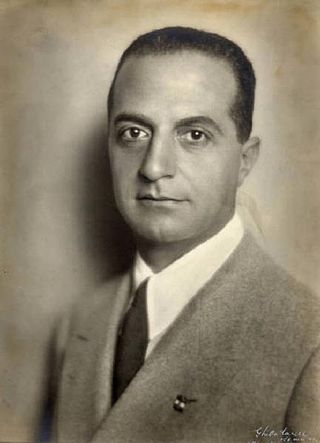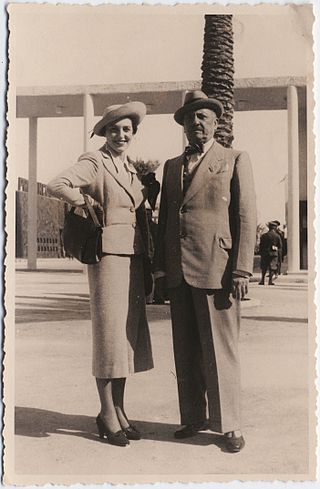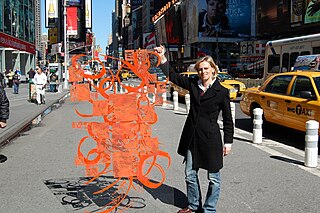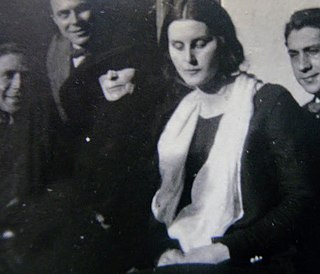
Giuseppe Bottai was an Italian journalist and member of the National Fascist Party of Benito Mussolini.

Via Nazionale is a street in Rome from Piazza della Repubblica leading towards Piazza Venezia.

Pio Piacentini was an Italian architect and the father of Marcello Piacentini. He is best known for his Palazzo delle Esposizioni in Rome.

The Rome Quadriennale is the Italian national institution entrusted with the task of researching about and promoting Italian contemporary art. It is a foundation participated by the Italian Ministry of Culture.

The Exhibition of the Fascist Revolution was an art exhibition held in Rome at the Palazzo delle Esposizioni from 1932 to 1934. It was opened by Benito Mussolini on 28 October 1932 and was the longest-lasting exhibition ever mounted by the Fascist regime. Nearly four million people attended the exhibition in its two years. Intended to commemorate the revolutionaries who had taken part in the rise to power of Italian fascism, the Exhibition was supposed to be, in Mussolini's own words, "an offering of faith which the old comrades hand down to the new ones so that, enlightened by our martyrs and heroes, they may continue the heavy task."
Enrico Del Debbio was an Italian architect and university professor.
The 15th Rome Quadriennale or XV Rome Quadriennale is an Italian art exhibition held between 19 June and 14 September 2008 at its historical site, the Palazzo delle Esposizioni of Rome, Italy.

Sheila McKinnon is a Canadian-born photographer and journalist who has lived most of her life in Italy. She has worked in Africa, Asia and Europe for The New York Times, Newsweek, Die Welt, Condé Nast, the International Herald Tribune, the Los Angeles Times, the Carnegie Foundation, the Knight Foundation, Saveur magazine, The Globe and Mail and other international and Italian publications including la Repubblica, il Messaggero, Corriere della Sera, l’Espresso, Panorama, Gente, Oggi, Artribune.com, Arte.it, Skytg 24, La Sapienza, Quotidiano di Sicilia, photographers.it, Kyotoclub.it, Mywhere.it.

Paolo Consorti is an Italian artist and film director.

Piergiorgio Colautti is a modern Italian painter and sculptor, who lived and worked in Rome. He is known for his own distinctive style, sometimes labelled "Hyperfuturism", in which figurative elements are enmeshed and submerged by symbols reflecting a cold and modern technological world.

Benedetta Cappa was an Italian futurist artist who has had retrospectives at the Walker Art Center and the Solomon R. Guggenheim Museum. Her work fits within the second phase of Italian Futurism.

Palazzo Fava or Palazzo Fava-Ghisilieri is a historic palace at 2 via Manzoni in Bologna, now housing art exhibitions and the Caffè Letterario Carracci Fava. It is most notable for its three rooms of frescoes of scenes from the lives of Jason, Medea, Europa and Aeneas by Ludovico Carracci, Agostino Carracci and Annibale Carracci, commissioned in 1584 by Filippo Fava - he was introduced to them by his tailor Antonio, Agostino and Annibale's father.
The stile Umbertino is a 19th-century style of Renaissance Revival architecture in Italy, typical of the eclecticism of late 19th century architecture and decorative arts in Europe, which mixes decorative elements from various historical styles.
Vincenzo Monaco was an Italian architect who collaborated with Amedeo Luccichenti from 1933 to 1963. During this period, Monaco designed more than 450 projects, of which approximately 100 were built. His work can be seen in buildings in Rome, Pisa, Naples, and Taranto, as well as in Dalmatia, Iran, France, and Tunisia.

Minya Mikic is an Italian artist, painter, and graphic designer. She lives and works between Rome and Zurich and regularly exhibits her work in Europe and New York.
Olga Napoli was an Italian painter, considered one of the most complex artists of the Southern Italian Post-World War II cultural landscape.

Stile Littorio denotes an architectural language developed in Italy in the 1930s and featured in a large number of public buildings commissioned by the Fascist regime until its fall.

Gabriele Patriarca was an Italian informal painter and member of the art movement Scuola Romana.

Elisa Johanne Rosa Maria Boglino was a Danish-Italian painter, active in Denmark and Italy.

Nino Camardo is an Italian naïve art painter.
















